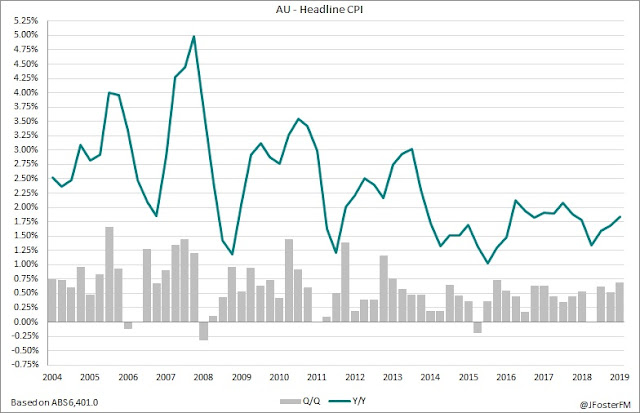Over in the UK, the Bank of England appears to be no closer to cutting rates as the Monetary Policy Committee (MPC) voted 7-2 to maintain the Bank Rate at 0.75% for the third straight meeting in what was Governor Mark Carney's last in charge. The tone of the MPC's decision statement highlighted a patient approach, noting signs of stabilisation in the global economy and reduced uncertainty for businesses and households over the nature of the UK's withdrawal from the EU, with these developments contributing to the Bank's constructive outlook in its Monetary Policy Report for GDP growth to pick up from its current below-trend pace to above trend over the coming year. However, at the post-meeting press conference, Governor Carney outlined that caution was warranted as trade tensions could re-emerge and other risks, such as the coronavirus, could weigh on the global economy, while these more positive signals from the UK would need to be translated into the hard data, most notably from business investment. Given these uncertainties, Governor Carney highlighted that if the expected recovery in the domestic economy were to falter, more policy support was an option for the MPC. In Europe, GDP growth disappointed estimates expanding by just 0.1% in Q4, while the annual pace eased from 1.2% to 1.0% to its slowest in 6 years, confirming the bloc's growth pulse softened further over the second half of 2019 as uncertainty continued to weigh on trade and business investment. Meanwhile, January's flash estimate of inflation lifted from 1.3% to 1.4% in annual terms, though this impulse was driven by volatile items as the underlying pace of inflation slowed from 1.3% to 1.1% over the year. More encouragingly, labour market slack in the bloc continues to tighten with the unemployment rate falling unexpectedly from 7.5% to 7.4% in December to its lowest since May 2008.
— — —
Turning to domestic developments, in last week's review we highlighted how market pricing for a February Reserve Bank of Australia had been scaled back significantly (from around 60% to a 20% chance) following December's much stronger-than-expected employment data. Expectations fell even further to a little above 10% this week following Q4's Consumer Price Index data. While the report was consistent with the familiar theme from recent years of an inflationary pulse that is low and steady, headline CPI at 0.7% in Q4 surprised slightly to the upside of consensus (0.6%) and annual growth was expected to remain at 1.7% but firmed to 1.8% (see our full review here). Meanwhile, the RBA's preferred trimmed mean CPI measure matched consensus in the quarter rising by 0.4% and though the annual pace remained at 1.6% this was above the 1.5% outturn expected and, more importantly, was in line with the Bank's official forecast. Thus, despite languishing below the RBA's 2-3% target range for 4 years now (see chart of the week, below), Q4's inflation data relative to the Bank's own expectations suggest a rate cut at next week's board meeting is unlikely.
Chart of the week
Also this week, NAB's Business Survey for December (note the results for this survey were collated in early January) showed a notable deterioration in confidence from a reading of 0 to -2 to be at its weakest in 6½ years, while conditions eased from +4 to +3 and remain at a well below-average level. The weakness in confidence aligns with a decline in capital expenditure to a below-average level, though at this stage employment intentions have held steady to point to jobs growth averaging around 18k per month for the next 6 months according to analysis from NAB Economics. For the outlook, the detail was soft with further weakness in forward orders and capacity utilisation at a subdued level.



























